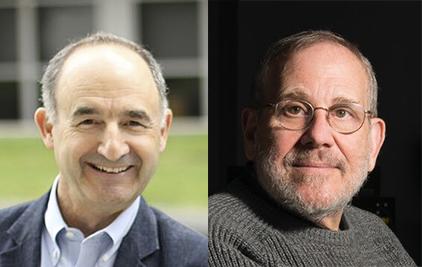Past winners include six scientists who went on to win the Nobel Prize

Credit: UNC
CHAPEL HILL, NC – The UNC School of Medicine has awarded the 19th Perl-UNC Neuroscience Prize to S. Lawrence Zipursky, PhD, of UCLA, and Joshua R. Sanes, PhD, of Harvard University for the “discovery of cell-surface proteins that control circuit assembly in the visual system.”
Zipursky and Sanes will visit Chapel Hill on March 21, 2019 to receive the prize – a $20,000 award – and give a lecture on their work at 3 p.m. in room G202 of the Medical Biomolecular Research Building (MBRB).
“Drs. Zipursky and Sanes have made significant contributions to our understanding of how different types of nerve cells interconnect with one another,” said Mark Zylka, PhD, Director of the UNC Neuroscience Center. “Their discoveries represent major advances in understanding how the nervous system ‘wires up’ to perform all of the everyday tasks such as seeing, moving, and thinking that we take for granted.”
The nervous system, which includes the brain and retinas, contains many different types of nerve cells that must interconnect with one another in a very precise manner. When faulty connections are made, problems such as seizures, intellectual disabilities, and blindness can arise. Discovering molecules that underlie this extraordinary specificity is a major goal of modern neuroscience. Both Zipursky and Sanes are leaders in this research field, illuminating our understanding of how the brain is built.
Zipursky, the Jerome J. Belzer Chair of Medical Research, Distinguished Professor of Biological Chemistry, and a Howard Hughes Medical Institute Investigator, earned his doctorate in molecular biology at the Albert Einstein College of Medicine and conducted postdoctoral work at the California Institute of Technology before joining UCLA in 1985.
Working with fruit flies, Zipursky discovered the Dscam1 (Down Syndrome Cell Adhesion Molecule 1) family of cell recognition molecules. The Dscam1 family has thousands of members that can provide individual neurons with a specific surface marker. These markers allow each type of nerve cell to avoid making connections with themselves as they form numerous connections with other nerve cells. This so-called “self-avoidance” is increasingly recognized as a key mechanism underlying synaptic specificity.
“It is incredibly gratifying to have my work acknowledged by the Perl-UNC Prize, Zipursky said. “I am particularly indebted to the students, postdoctoral fellows, and collaborators whose creativity, hard work, and persistence led to the surprising discoveries for which I am being honored. I am delighted to share this award with my good friend Josh Sanes. Our shared passion for work in this area has helped make studying the complexity and specificity of brain wiring so much fun.”
Sanes, the Jeff C. Tarr Professor of Molecular and Cellular Biology and the Paul J. Finnegan Family Director of the Center for Brain Science, earned his doctorate in neurobiology from Harvard and conducted postdoctoral research at the University of California-San Francisco before joining the faculty of Washington University in St. Louis in 1984. He held an endowed chair there before returning to Harvard in 2004.
Using laboratory mice, Sanes determined how specific connections within different layers of the retina form. He identified a family of molecules known as “sidekicks” that cause neurons to make contact with and adhere to their appropriate partners. These molecules channel the contacts between different types of nerve cells to specific retinal layers. Layer specificity is a fundamental organizing principle in many parts of the nervous system.
“It’s a real thrill to join the incredible luminaries who have been honored by the Perl-UNC Prize over the years, and a special treat to win it with my friend, colleague, and collaborator, Larry Zipursky,” Sanes said. “I view the prize as recognizing the community of basic neuroscience researchers who use a variety of model systems to learn how the brain gets made. It’s a good time to be doing this, as evidence mounts that defects in the assembly of this ridiculously complex structure may underlie most psychiatric and many neurological disorders.”
###
The Perl-UNC Neuroscience Prize is increasingly well known among biomedical scientists. Six of its previous winners went on to win the Nobel Prize in Physiology or Medicine or the Nobel Prize in Chemistry. One of last year’s awardees, Dr. Doris Tsao, subsequently received a MacArthur Fellows “Genius” Grant.
The Perl-UNC Neuroscience Prize, established in 2000, is named after former UNC professor Edward Perl, MD, who discovered that a specific type of sensory neuron responded to painful stimuli. Before this, scientists thought that sensory neurons responded to all stimuli and that pain responses were sorted out in the spinal cord. The discovery had a major impact on the field of pain research, particularly in the development of pain medications.
Dr. Perl passed away in 2014. Read more about his research in this remembrance.
Along with Mark Zylka, the Perl-UNC Neuroscience Prize selection committee consists of William Snider, MD, professor of neurology and founding director of the UNC Neuroscience Center; Ben Philpot, PhD, professor of cell biology and physiology and associate director of the UNC Neuroscience Center; Thomas Albright, PhD, Conrad T. Prebys Chair in Vision Research at the Salk Institute; Vanessa Ruta, PhD, the Gabriel H. Reem & Herbert J. Kayden Assistant Professor of Neurophysiology & Behavior at Rockefeller University; Julie Kauer, professor of neurosciences & medical sciences at Brown University; and Regina Carelli, the Stephen B. Baxter Distinguished Professor and Associate Chair of the Department of Psychology & Neuroscience at the University of North Carolina.
Media Contact
Mark Derewicz
[email protected]
984-974-1915
Original Source
http://news.




